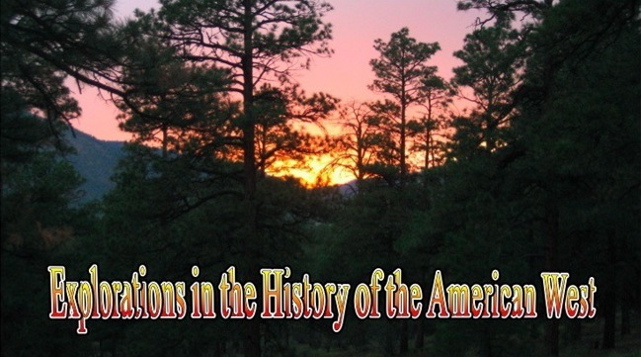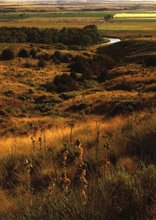 Historians of the American West have been studying violence for decades and their conclusions show that this region, while possessing many colorful characters whose exploits have become mythologized by other Americans, was not any more violent than say, the Northeast, where cities like New York witnessed far more acts of violence and crime on a per capita basis than did any state or territory in the West during the 19th century. So the West was not a lawless region; however, as historian William C. Davis argues, "the romantic appeal of the West shrouded its criminality with an extra aura of violent romance".
Historians of the American West have been studying violence for decades and their conclusions show that this region, while possessing many colorful characters whose exploits have become mythologized by other Americans, was not any more violent than say, the Northeast, where cities like New York witnessed far more acts of violence and crime on a per capita basis than did any state or territory in the West during the 19th century. So the West was not a lawless region; however, as historian William C. Davis argues, "the romantic appeal of the West shrouded its criminality with an extra aura of violent romance". According to most historians of violence in the West, among these was Eugene Hollon a former professor of history at the University of Toledo, there are several reasons why the West came to have such a violent reputation and why the nation mythologized the violence that took place in the region, thereby exacerbating the effects of any violent act by making it seem much more significant. Top among the reasons for the violent reputation of the West is the fact that the fringe regions of civilization have always attracted "non-conformists" and anti-social types. Far from the restraining influences of government and society, men and women who were possessed of lawless tendencies found the West to their liking. Those individuals who chose the profession of highwayman and bandit would soon discover that although significant amounts of freedom the likes of which eluded them in the East could be found west of the 100th meridian, the lifestyle was a hard one. By all accounts the life of an outlaw was seedy, unglamorous, dangerous, and ultimately deadly with little hope of economic improvement for their material situations.
According to most historians of violence in the West, among these was Eugene Hollon a former professor of history at the University of Toledo, there are several reasons why the West came to have such a violent reputation and why the nation mythologized the violence that took place in the region, thereby exacerbating the effects of any violent act by making it seem much more significant. Top among the reasons for the violent reputation of the West is the fact that the fringe regions of civilization have always attracted "non-conformists" and anti-social types. Far from the restraining influences of government and society, men and women who were possessed of lawless tendencies found the West to their liking. Those individuals who chose the profession of highwayman and bandit would soon discover that although significant amounts of freedom the likes of which eluded them in the East could be found west of the 100th meridian, the lifestyle was a hard one. By all accounts the life of an outlaw was seedy, unglamorous, dangerous, and ultimately deadly with little hope of economic improvement for their material situations.Violent crime had existed in the West long before the United States conquered the region in the Mexican War and before even Lewis and Clark headed west in 1803. For over 200 years of Spanish occupation, the Southwest and parts of the Great Plains had witnessed violence as new cultures came into conflict on the sparsely populated borderlands of New Spain. When the Americans came during the 19th century, little would change. As was mentioned previously, the West was not a lawless region. While the perception existed that the West was free of invasive government and social influence, there were vigilance committees like those established in the California and Colorado mines as well as citizens who were willing to carry out their own form of justice on criminals. A criminal element existed alongside an element that was quite capable of inflicting significant punishment. While we generally think of crime in the West in the form of shootouts and bank robberies, the number one crime reported in that region was actually embezzlement followed by petty theft.
 The myth of the riotous trailman, causing trouble and destruction at the railhead after a long haul on the cattle trails is also just that, a myth. While cowboys were known to cause trouble for cow towns including drunken brawls and saloon fights, no one town held their position as a railhead for any considerable time for rowdy cowboys to get too much out of hand and to cause local citizens much inconvenience. This is not to say that the violence which did occur in some of these cattle towns, notable Dodge City, Kansas, were insignificant; it is more likely that stories of their violence have been greatly exaggerated by an American public that was willing to believe such tales about the "lawless" West, as it was perceived to be.
The myth of the riotous trailman, causing trouble and destruction at the railhead after a long haul on the cattle trails is also just that, a myth. While cowboys were known to cause trouble for cow towns including drunken brawls and saloon fights, no one town held their position as a railhead for any considerable time for rowdy cowboys to get too much out of hand and to cause local citizens much inconvenience. This is not to say that the violence which did occur in some of these cattle towns, notable Dodge City, Kansas, were insignificant; it is more likely that stories of their violence have been greatly exaggerated by an American public that was willing to believe such tales about the "lawless" West, as it was perceived to be. The first of the well known gang of outlaws in the West got their start following the Civil War. This was the James Gang, which consisted of Jesse and his older brother Frank. Later the James brothers would be joined by their cousins, the Youngers. The James Gang was the first in a series of family crime gangs that can be identified in books written about violence of the American West today. Other gangs would include the Dalton Gang, the Clanton's, and the Reno brothers. Few of these individuals would live to see old age as their profession was quite dangerous. Following the Civil War many ex-Confederates would head West and take up the highway bandit or bank robbing profession. These were men who had been trained in some cases as guerrilla fighters and in many cases they were reacting to what was deemed to be heavy handed Reconstruction tactics on the part of the North. A surplus of disenfranchised and militarily trained young men would create a niche for themselves out West and some, like the James Gang, would claim that they only targeted Yankee banks, Yankee stage coaches, etc.
The first of the well known gang of outlaws in the West got their start following the Civil War. This was the James Gang, which consisted of Jesse and his older brother Frank. Later the James brothers would be joined by their cousins, the Youngers. The James Gang was the first in a series of family crime gangs that can be identified in books written about violence of the American West today. Other gangs would include the Dalton Gang, the Clanton's, and the Reno brothers. Few of these individuals would live to see old age as their profession was quite dangerous. Following the Civil War many ex-Confederates would head West and take up the highway bandit or bank robbing profession. These were men who had been trained in some cases as guerrilla fighters and in many cases they were reacting to what was deemed to be heavy handed Reconstruction tactics on the part of the North. A surplus of disenfranchised and militarily trained young men would create a niche for themselves out West and some, like the James Gang, would claim that they only targeted Yankee banks, Yankee stage coaches, etc.To continue the theme of how the West's violent reputation developed, some historians have identified the passive emphasis on security that was prominent in many communities of the West during the 19th century. Many communities believed that locks on doors were unnecessary as they knew their neighbors and held the belief that good neighbors did not steal from each other. In many communities of the West, some banks did not even have safes in which to store deposits, they either relied on a lock box (I have no idea if this is the same lock box that Al Gore would later reference in the 2000 election) or the bank manager would take the savings deposits home each night. This is the environment in which gangs started to organize and eventually two of the most famous events that occurred in the 19th century West would come to pass: the fight at the O.K. Corral and the Lincoln County War. I will write a blog on each of these events soon.
 Finally, the great Western historian W. Eugene Hollon wrote an interpretation of Frontier Violence in 1974, still viewed as a classic work in this field. In this monograph, Hollon describes the traditional reasons for why the West had a reputation for violence and then he offers several (at the time) new reasons which are quite insightful. According to Hollon, "the cause of violence on the frontier was related more to anxiety, tension, frustration, and prejudice than any action by outlaws, Indian fighters, or vigilante groups".
Finally, the great Western historian W. Eugene Hollon wrote an interpretation of Frontier Violence in 1974, still viewed as a classic work in this field. In this monograph, Hollon describes the traditional reasons for why the West had a reputation for violence and then he offers several (at the time) new reasons which are quite insightful. According to Hollon, "the cause of violence on the frontier was related more to anxiety, tension, frustration, and prejudice than any action by outlaws, Indian fighters, or vigilante groups".The magnetism the fringe region of society has towards non-conformists and anti-social types, the general disregard for more stringent community security standards, disenfranchised and militarily trained young men, and anxiety, tension, frustration and prejudice. All of these reasons combined with a strong desire of the other regions of the United States to see the West as it was perceived to be: wild and untamed. In the end the nation fixed on the myth of the West as a Violent region.



2 comments:
Do you by chance know who painted this beautiful image of Smithsonian Butte on your blog page?
Post a Comment